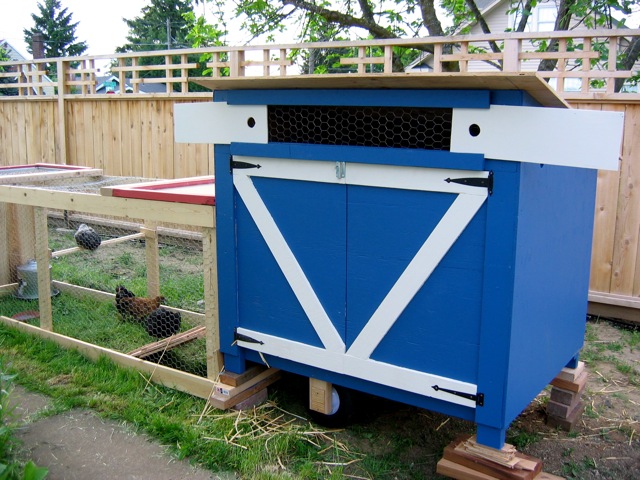
reference-image, l
(post, Caroline Cummins)
On Thursday, May 15, summer arrived. What had felt, for the first four months of 2008, like endless winter — cold days, drizzly skies — abruptly died, chased out with sunshine and temperatures in the 90s. I grumbled a bit — weren't we supposed to have spring before crashing into summer? — but I wasn't suffering as much as the chickens. Because their starter home (cardboard boxes atop straw and newspaper) was basically inside a greenhouse, the poor birds were quickly turning into broiler chickens. Did you know that chickens, when hot, open their beaks and pant like dogs? Well, now you do. [%image coop float=right width=400 caption="The new chicken run (left) and chicken coop (right)."] So my husband, who had almost finished building the chicken coop and was working on the chicken run, quickly assembled a makeshift run in the back yard. We plopped the chickens inside the run, where, after a few startled minutes, they began to peck at the grass growing underneath their feet. Grass! Bugs! Fresh air! The birds spent the next few hours wobbling back and forth inside the run. At night, we stuck one of the cardboard boxes inside the run as a security blanket, and the birds piled into a heap in one corner and went to sleep under the stars. We're not sure, because we forgot to ask at the store, but we think our chickens are between five and six weeks old. They're mostly "feathered out," as chicken folk like to say, but they're still only about a fourth to a third of their eventual size. Watching them in their run, I thought they looked a little cramped, even at their puny size. But as my husband pointed out, the space they do have — 20 square feet in the run, with another 12 square feet inside the coop — is extravagantly generous compared to the space allotted to battery hens in egg factories, which is generally less than a single square foot per bird. Ouch. On Saturday, the coop was finally finished and rolled out to join the run. My husband, who spent many hours sketching designs and doing math and sawing and sanding and hammering, is deservedly proud of his coop, which he painted with blue latex dubbed "Crater Lake" from Metro Paint and banged together with hinges from Hippo Hardware. He installed a removable bottom (easier to clean), a roost, wire-covered vents, and an elevated nesting box. [%image birds float=left width=300 caption="The chickens in their run, watched by the cat (upper left)."] But the six chickens were not impressed. They huddled at the far end of the run, nervous, while my husband attached the heavy wooden coop to the other end and propped a little wooden chicken ramp inside the run for the birds to walk up into the coop. No dice; the birds weren't going anywhere near the big blue box. But when twilight rolled around, the orange Araucana (whom we've been calling Tuffy, because she seems to be the Boss Chicken) started twittering loudly to get the other birds' attention. Then she stalked proudly up the ramp into the coop and staked out a spot in the straw. Slowly, the other birds followed. (Are Australorps dumber than Araucanas? Maybe; they were definitely the slowest to get with the ramp system.) By nightfall, they had all made their usual slumber party in the straw and zonked out. At five a.m. they woke up and began cooing and murmuring in anticipation of the day. Me, I kind of wish they weren't so thrilled by the dawn — at least not outside my bedroom window. But they shut up after a while, and when I finally got up and went outside to check on them, they were out in the chicken run, pecking around like the early birds they are. By the time night fell again, they had the whole coop-versus-run thing figured out: run for daytime, coop for nighttime. We shut them inside their coop for the night and left them there, purring contentedly like feathered cats.

reference-image, l

coop, l

birds, l